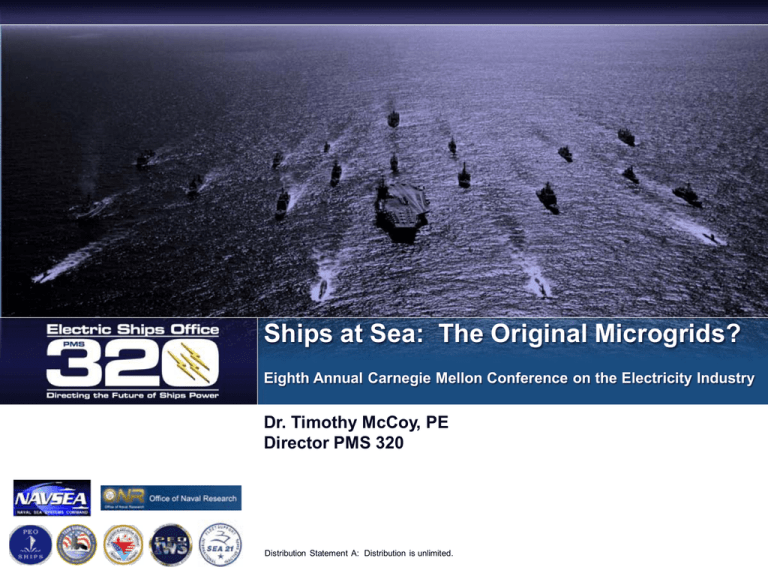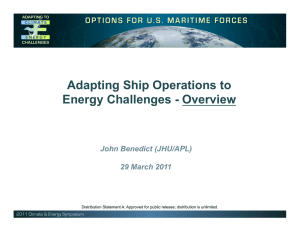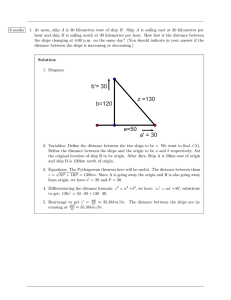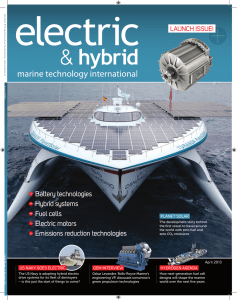Ships at Sea: The Original Microgrids? Dr. Timothy McCoy, PE
advertisement

Ships at Sea: The Original Microgrids? Eighth Annual Carnegie Mellon Conference on the Electricity Industry Dr. Timothy McCoy, PE Director PMS 320 Distribution Statement A: Distribution is unlimited. 1 Outline ◆ Brief History of Electricity in the US Naval Fleet ◆ Today’s Marine Power System Drivers – Naval Ships – Commercial Ships ◆ Shipboard Power Systems vs. Terrestrial Power Systems ◆ Ongoing Developments ◆ Summary Content subject to Distribution Statement on cover page. 2 United States Navy “Without a Navy the Nation’s commerce will be at the mercy Of any who would choose to prey upon it” - Alexander Hamilton Content subject to Distribution Statement on cover page. 3 US Navy Electric Ships History ASMP focus on AC ZEDS (DDG 51 Flight IIA) , ICR, and reduced scale PM Development 1984 - Integrated electric Propulsion evaluated for FFX—ship program cancelled Subscale superconducting ship applications analyses, including pod designs. 1995 – IPS Full Scale Advanced Development 1988 – CNO ADM Trost designated IED for surface combatants 2010 1988-1989 - Advanced and Integrated Electric Propulsion developed for NAVSEA IED alternatives for DDGX started T-AG, T-ARC, T-AGOR, T-AGOS… 2020 Commercial IPS T-AKE 2000s 1990s USS Trenton; USS Langley; USCGC Modoc; USS New Mexico; T-2 Tanker 18771960 1980s 1970s Electric Weapons Support Advanced Sensors (AMDR) Open Architecture Systems EMALS / AAG Whole Ship UPS Architecture 400hz Point of Use Power Conversion Improved Fuel Efficiency and Increased Power Density 2007 - Next Generation IPS Roadmap Published 2007 – Electric Ships Office (PMS 320) Established Integrated Fight Through Power (IFTP) Development 2000 – SECNAV determines DDG 1000 will be IPS A History of Successful Development and Transition Content subject to Distribution Statement on cover page. 4 History of U.S. Navy Electric Ships USS JUPITER (AC 3) Commissioned 1913 USS LANGLEY (CV 1) Recommissioned 1922 Collier First U.S. Navy Aircraft Carrier Content subject to Distribution Statement on cover page. 5 History of U.S. Navy Electric Ships USS NEW MEXICO (BB 40) Commissioned 1918 U.S. Navy’s First Electric Propulsion Combatant Content subject to Distribution Statement on cover page. 6 Shipboard Power & Propulsion Systems Steam ships are ‘integrated’ on the steam side Reduction Gear Steam Turbine Steam Turbine Generator To Ship Service Loads Condenser For Surface ships, ‘Integration’ was lost when we transitioned to internal combustion engines Reduction Gear IPS brings back ‘integration’ on the electrical side, enabled by: • Solid State Power Electronics • Multi-Megawatt Motor Drives • Automated Controls Propulsion Motor Power Conversion Module Content subject to Distribution Statement on cover page. Prime Mover Motor Drive Steam Source De-aerating Feed Tank Feed Pump Generator Prime Mover Generator Prime Mover To Ship Service Loads Main Power Distribution Ship Service Power Generator Prime Mover 7 U.S. Navy Fuel Usage and Trends • Surface ships account for 40% of Navy fuel consumption • Fuel cost uncertainty (~400% per bbl increase since FY03) Aviation 47% Shore 5% Vehicles 7% Other 1% Ships 40% • Energy (fuel) Demand Increasing – Combat / Weapons Power – Force Structure Changing: Higher Fuel Consumption – Operational Requirements • Why focus on DDG 51 Class? – Provides best opportunity for long term payoff given platform age, production restart, and quantity Content subject to Distribution Statement on cover page. 8 Opportunities for Energy Savings • Prime Movers • Ship Propulsion – Propulsor efficiency – Hullform resistance – Energy Recovery • Electrical Loads – – – – • Fans / Pumps Mission Systems Lighting Variable Frequency Drives Relative Efficiencies – Technical advances – Combined cycles Operating Concepts – Alternate Architecture optimizes Fuel Consumption Alternate Architectures Maximizes Energy Savings Content subject to Distribution Statement on cover page. 9 Warfighting Needs Drive Power Systems Affordability Gap (Electric Power Online) Available Power Integrated Architectures Traditional Architectures Age of Guns Age of Guns and Missiles Age of Guns, Missiles, Directed Energy & Hypervelocity Weapons Increased demands for power will continue for the foreseeable future Content subject to Distribution Statement on cover page. 10 Mission Systems: Increasing Electrical Power Demands Deployed Mission Capability 2014 0.4 MW Weapon System Development TRL=6 Weapon Development TRL=4/5 Technology Development TRL=3/4 2016 2020 2020+ 0.7 MW 30 MW 20 MW Active Denial System Solid State Laser Power Demands per Mount Multiple Mounts per ship ElectroMagnetic Rail Gun Free Electron Laser Laser Weapon System Sensor and Weapon System Power Demands will soon rival Propulsion Power Demands Content subject to Distribution Statement on cover page. 11 Example Ship Power System Loads Power (MW) Idealized Aircraft Launch Power Pulse Energy = 122 MJ Placeholder for Videos Time Idealized Rail Gun Power Pulse 14000 12000 Power (MW) 10000 8000 6000 Energy = 115 MJ 4000 2000 0 0.99 1 1.01 1.02 Time (sec.) Content subject to Distribution Statement on cover page. 12 Loads Behaving Badly Pulse Comparison 14000 12000 8000 Rail Gun 6000 EMALS 4000 2000 0 0 1 2 Time (sec.) 3 4 Notional Radar Power 20 15 Power Power (MW) 10000 10 5 0 Content subject to Distribution Statement on cover page. Time 13 Commercial Marine Power Systems Design Drivers ◆ IMO MARPOL Annex VI Emissions Regulations – Limits NOX Emissions – Limits Fuel Sulfur Content – Requires implemenation of: • Energy Efficiency Design Index (EEDI), for new ships • Ship Energy Efficiency Management Plan (SEEMP) for all ships. MARPOL Annex VI NOX Limits1 Content subject to Distribution Statement on cover page. MARPOL Annex VI Sulfur Limits1 1 www.dieselnet.com 14 Commercial Marine Power Systems Design Drivers ◆ Increasing Fuel Prices Bunker Fuel Price Index1 Crude Oil Price History2 1 Content subject to Distribution Statement on cover page. 2 www.bunkerworld.com US Energy Information Administration 15 Terrestrial vs. Marine Power Systems Terrestrial Power Systems • Structure – generally radial • Large numbers of generators, busses, transmission lines, loads • Constant frequency – linearized about an operating point • Load flow analysis • Market Implications Marine Power Systems • Structure – zonal / mesh • Small number of generators, busses, negligible transmission lines • Large transients, often not linearizeable • Frequency domain analysis • No market implications 16 Ongoing US Navy Power System Developments Reduce DDG 51 Class in-service fuel consumption Provides propulsion at low ship speeds without the need for LM 2500 main engines Assure mobility, lighten the load, expand tactical reach, and green our footprint Hybrid Electric Drive Electric Propulsion System Power conversion from ship current to 1000 VDC for the AMDR Potential for faster switching frequencies and higher temp. operation Smaller footprint Provide fuel efficient and affordable power to meet power requirements for advanced sensors and future weapons Reduction in weight and lower life cycle costs Up to 17% reduction in fuel consumption over the DDG 51 FLT IIa GTG Advanced Power Generation Module & Gas Turbine Efficiency Improvements Affordable P&E Solutions Energy Storage Module Power Conversion Module (PCM-1A) Propulsion Derived Ship Service PCM-4 Envelope 81” 3x20” 60” 168 ” 60 ” Ship Service electrical power from propulsion system through reduction gear Content subject to Distribution Statement on cover page. De-risking Single Generator Operations High efficiency GTGs used with no electrical system degradation Support pulsed power requirements of advanced weapons 17 Summary ◆ Shipboard Power Systems are evolving due to increases in load demands, environmental regulations and fuel prices ◆ Terrestrial Power Systems are evolving due to increases in load demands, environmental regulations, fuel prices and market deregulation ◆ Incorporation of distributed, renewable generation sources and smart grid technologies may make terrestrial systems behave more closely to shipboard systems Content subject to Distribution Statement on cover page. 18 Questions? Content subject to Distribution Statement on cover page. 19






